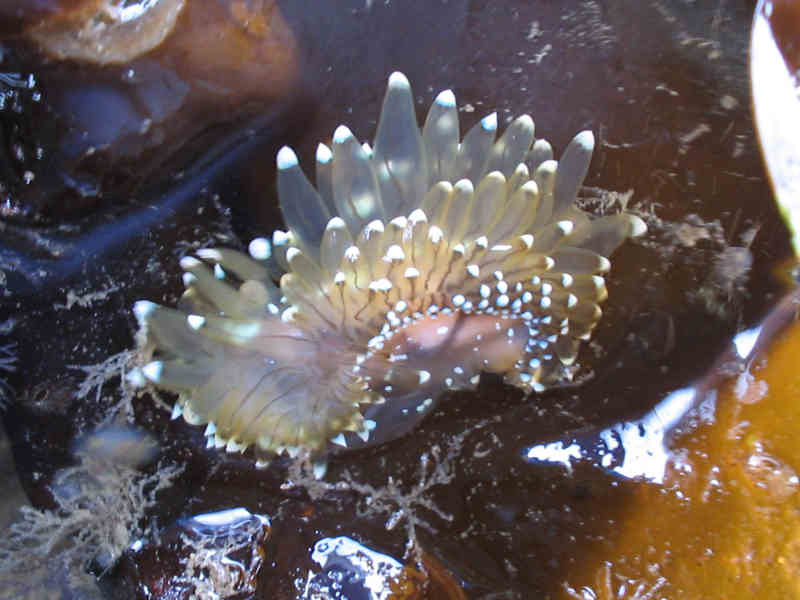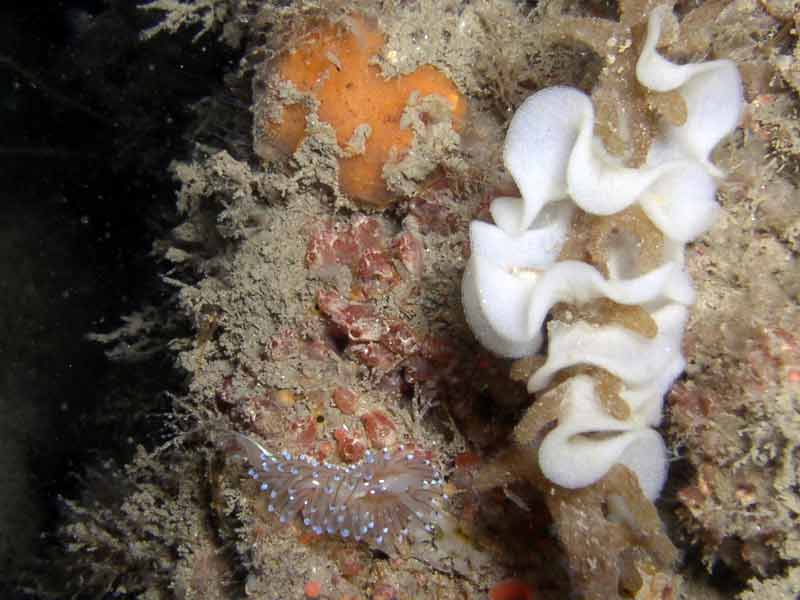Crystal sea slug (Antiopella cristata)
Distribution data supplied by the Ocean Biodiversity Information System (OBIS). To interrogate UK data visit the NBN Atlas.Map Help
| Researched by | Judith Oakley | Refereed by | This information is not refereed |
| Authority | (Delle Chiaje, 1841) | ||
| Other common names | Crested aeolis | Synonyms | Janolus cristatus (Delle Chiaje, 1841) |
Summary
Description
Antiopella cristatus is a semi-transparent nudibranch growing to at least 7.5 cm. The body is oval and flattened. There are numerous swollen cerata, each with a central thin dark thread of digestive gland. The cerata tips contain an iridescent bluish-white pigment. Similar patches of pigment are found on the back, between the cerata and in the head region. The lamellate rhinophores are especially large and conspicuous, non-retractile and without sheaths. A coarsely ridged, sensory cocks comb-like structure called a caruncle lies between the rhinophores, which is unique to Janolus and Antiopella genera.
Recorded distribution in Britain and Ireland
Recorded from most British and Irish coasts except the southeast, reaching its northern distribution limit around the Shetland Isles.Global distribution
Recorded from southern Norway, along the Atlantic French coast to Morocco. In the Mediterannean Sea from southern France and the Bay of Naples.Habitat
Janolus cristatus lives in shallow sublittoral conditions, especially on sheltered rocky coasts. They feed on erect tufted bryozoans such as Bugula and Cellaria species.Depth range
-Identifying features
- A large species up to 7.5 cm long.
- The body is pale brown or cream in colour but the rhinophores are darker, tending towards amber.
- Oval in outline and flattened dorso-ventrally.
- Cerata extend across front of body, each with a central thin dark thread of digestive gland.
- Cerata tips with irridescent bluish-white pigment.
- Lamellate rhinophores are large, conspicuous and non-retractile.
- Caruncle between rhinophore bases.
Additional information
Spawning has been recorded from April to September and in December (Thompson & Brown, 1984). The egg-mass contains a series of bead-like white or pale pink ovoids, each being a capsule containing up tp 250 separate individual spherical eggs (ova). The spawn is wound in a wavy circle pattern (Thompson & Brown, 1984).
Listed by
- none -
Bibliography
Hayward, P.J. & Ryland, J.S. (ed.) 1995b. Handbook of the marine fauna of North-West Europe. Oxford: Oxford University Press.
Howson, C.M. & Picton, B.E., 1997. The species directory of the marine fauna and flora of the British Isles and surrounding seas. Belfast: Ulster Museum. [Ulster Museum publication, no. 276.]
JNCC (Joint Nature Conservation Committee), 1999. Marine Environment Resource Mapping And Information Database (MERMAID): Marine Nature Conservation Review Survey Database. [on-line] http://www.jncc.gov.uk/mermaid
MarLIN (Marine Life Information Network), 2005. SEArchable BEnthic Data (SEABED) Map [on-line]. Data Access Sub-programme, Marine Life Information Network for Britian and Ireland http://www.marlin.ac.uk,
Picton, B. E. & Morrow, C.C., 1994. A Field Guide to the Nudibranchs of the British Isles. London: Immel Publishing Ltd.
Picton, B.E. & Costello, M.J., 1998. BioMar biotope viewer: a guide to marine habitats, fauna and flora of Britain and Ireland. [CD-ROM] Environmental Sciences Unit, Trinity College, Dublin.
Rudman, W.B., 1999c. Janolus cristatus [on-line]. http://www.seaslugforum.net/factsheet.cfm?base=janocris,
Thompson, T.E. & Brown, G.H., 1984. Biology of Opisthobranch Molluscs, vol. II. London: Ray Society.
Datasets
Centre for Environmental Data and Recording, 2018. Ulster Museum Marine Surveys of Northern Ireland Coastal Waters. Occurrence dataset https://www.nmni.com/CEDaR/CEDaR-Centre-for-Environmental-Data-and-Recording.aspx accessed via NBNAtlas.org on 2018-09-25.
Conchological Society of Great Britain & Ireland, 2018. Mollusc (marine) data for Great Britain and Ireland - restricted access. Occurrence dataset: https://doi.org/10.15468/4bsawx accessed via GBIF.org on 2018-09-25.
Conchological Society of Great Britain & Ireland, 2023. Mollusc (marine) records for Great Britain and Ireland. Occurrence dataset: https://doi.org/10.15468/aurwcz accessed via GBIF.org on 2024-09-27.
Fenwick, 2018. Aphotomarine. Occurrence dataset http://www.aphotomarine.com/index.html Accessed via NBNAtlas.org on 2018-10-01
Manx Biological Recording Partnership, 2022. Isle of Man historical wildlife records 1990 to 1994. Occurrence dataset:https://doi.org/10.15468/aru16v accessed via GBIF.org on 2024-09-27.
NBN (National Biodiversity Network) Atlas. Available from: https://www.nbnatlas.org.
OBIS (Ocean Biodiversity Information System), 2025. Global map of species distribution using gridded data. Available from: Ocean Biogeographic Information System. www.iobis.org. Accessed: 2025-07-29
Citation
This review can be cited as:
Last Updated: 04/11/2005






